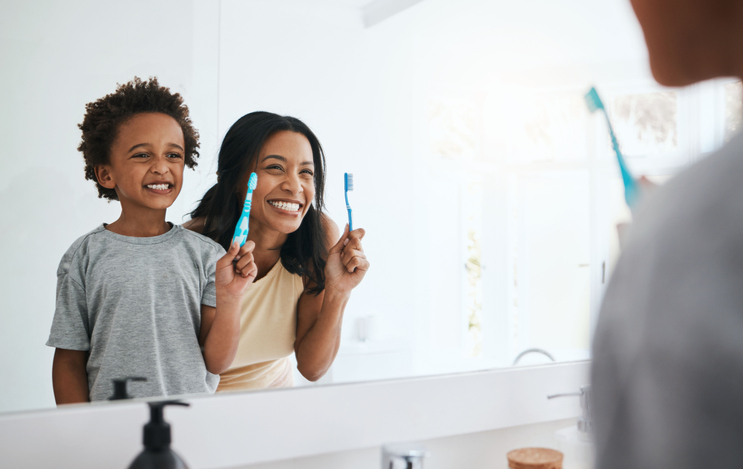How to Properly Brush Your Teeth
- Brush for at least 2 minutes – Brush twice a day, in the morning and at night.
- Brush all surfaces – Brush the outer, inner, and chewing surfaces of your teeth.
- Use fluoride toothpaste – use a toothpaste with at least 1,350 parts per million (ppm) fluoride.
- Replace your toothbrush – Replace your toothbrush every 4-5 months or when it shows wear. You should also replace it after you’ve been sick
- Use a soft-bristled brush: A small-headed brush with medium-textured bristles is ideal.
How to Properly Brush Your Teeth: The Dentist-Recommended Way
When it comes to oral health, brushing your teeth seems like a basic task. But doing it properly makes all the difference. At Smiles for Leesburg, we often see patients who brush regularly but still suffer from gum issues, enamel wear, or tooth decay—simply because their technique needs work. This guide breaks down everything you need to know to brush your teeth the right way and protect your smile for life.
Why Proper Brushing Matters
Brushing isn’t just about keeping your breath fresh—it’s a critical part of your health routine. Improper brushing can lead to:
- Gum disease (gingivitis and periodontitis)
- Cavities and tooth decay
- Enamel erosion
- Stained teeth and bad breath
When done correctly, brushing removes plaque—a sticky biofilm full of bacteria that damages your gums and teeth. A good brushing routine also boosts your confidence and supports overall wellness.
How Often Should You Brush?
As a rule of thumb, brush your teeth twice daily—once in the morning and once before bed. Nighttime brushing is especially important because it removes the day’s food debris and bacteria before you sleep, preventing overnight buildup. For individuals with braces or dental appliances, brushing after meals is recommended.
Choosing the Right Toothbrush
- Bristles: Always use a soft-bristled brush to prevent gum damage and enamel erosion.
- Size: Pick a brush that fits comfortably inside your mouth and can reach all areas, including your back molars.
- Electric or manual: Both are effective when used properly, but electric brushes often remove more plaque and help you stay consistent.
Make sure to replace your toothbrush or brush head every 3–4 months, or sooner if the bristles become frayed.
Step-by-Step Brushing Technique
Follow this dentist-approved method to ensure you’re brushing effectively:
- Apply a pea-sized amount of fluoride toothpaste.
- Hold your brush at a 45-degree angle to your gums.
- Use short, gentle strokes in a circular motion—not aggressive back-and-forth scrubbing.
- Start with the outer surfaces, then move to the inner sides, and finish with the chewing surfaces.
- Don’t forget your tongue—brushing it helps fight bad breath.
- Brush for at least two full minutes.
- Rinse your brush thoroughly after use and store it upright to air-dry.
When Should You Brush?
Many people brush right after meals, but this can harm your enamel if you’ve eaten acidic foods (like citrus or soda). It’s best to wait 30 minutes after eating before brushing, or rinse your mouth with water and brush later.
Other Oral Hygiene Essentials
Brushing alone isn’t enough for a healthy mouth. Here’s what else you should include:
- Floss daily to remove plaque between teeth.
- Use antibacterial mouthwash to reduce bacteria and freshen breath.
- Chew sugar-free gum between meals to stimulate saliva and fight decay.
- Schedule cleanings twice a year with your dentist.
Signs You Might Be Brushing Wrong
- Bleeding gums: Often caused by brushing too hard or skipping flossing.
- Tooth sensitivity: May result from using a hard brush or abrasive toothpaste.
- Persistent bad breath: Could signal plaque left behind from poor brushing technique.
If you’re noticing these issues, it might be time to book a consultation with a dental hygienist at Smiles for Leesburg.
How Kids Should Brush
Children should begin brushing as soon as their first tooth erupts, with supervision until age 7 or 8. Use a toothbrush designed for kids and a rice-sized smear of fluoride toothpaste. Teaching good habits early helps prevent dental anxiety and future issues.
Professional Care Matters
No matter how well you brush, tartar can still build up over time. That’s why professional dental cleanings are essential. Your hygienist can remove buildup, check for early signs of decay, and offer personalized brushing tips.
Visit Smiles for Leesburg
At Smiles for Leesburg, we believe that excellent oral hygiene starts at home—with a solid brushing routine—and continues with professional care. Our team offers friendly, comprehensive services tailored to your needs.
To learn more, explore our Preventive Dentistry page or schedule a cleaning today.
???? Smiles for Leesburg
8305 County Rd 44 Leg A
Leesburg, FL 34788
Phone: (352) 504-3530
smilesforleesburg.com




